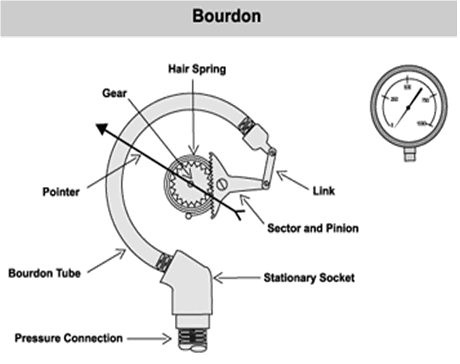Bigscience
Well-Known Member
I used to have beers that were overcarbed and I had to way lower the pressure to pour them. The needle was stopped on the peg while there was still ~8 psi. I ended up replacing it and everything is now great. The way I found out was when I added a 4-way secondary. I should have been able to set the tank gauge at a pressure, say 10 psi and no matter how high I cranked up the other regulators, they should go higher than that.
I was able to calibrate the gauge to +/- 2psi but it was a total PITA. So here's what the inside of the gauge looks like:

As the pressure increases, the Bourdon Tube wants to straighten out, like a let's say "balloon". This causes the pinion to turn the dial. To adjust, you have to turn the needle either higher or lower until the pinion teeth come off the gear and then move the needle a tooth or two one way or the other. It's really easy to over shoot and have to go back the other way. Oh, this will only work if you have a known good gauge to compare it too. You would need to set your tank secondary to say 15 psi and then crank up your secondary (the one you want to adjust) and then try to adjust until it is at the same pressure. Unless you really like a challenge or don't have the money for a new gauge, just buy a new one.
I was able to calibrate the gauge to +/- 2psi but it was a total PITA. So here's what the inside of the gauge looks like:

As the pressure increases, the Bourdon Tube wants to straighten out, like a let's say "balloon". This causes the pinion to turn the dial. To adjust, you have to turn the needle either higher or lower until the pinion teeth come off the gear and then move the needle a tooth or two one way or the other. It's really easy to over shoot and have to go back the other way. Oh, this will only work if you have a known good gauge to compare it too. You would need to set your tank secondary to say 15 psi and then crank up your secondary (the one you want to adjust) and then try to adjust until it is at the same pressure. Unless you really like a challenge or don't have the money for a new gauge, just buy a new one.


















































![Craft A Brew - Safale S-04 Dry Yeast - Fermentis - English Ale Dry Yeast - For English and American Ales and Hard Apple Ciders - Ingredients for Home Brewing - Beer Making Supplies - [1 Pack]](https://m.media-amazon.com/images/I/41fVGNh6JfL._SL500_.jpg)






